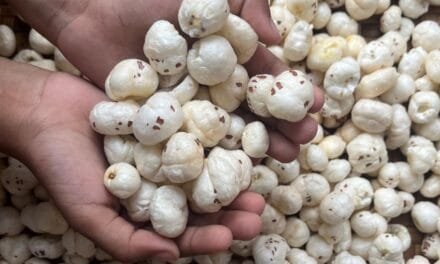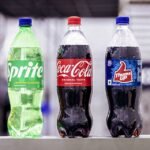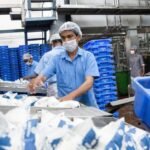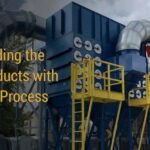Today, customers and stakeholders demand that food companies operate more sustainably. To meet this demand, adopting circular economy principles is crucial. However, there’s no one-size-fits-all approach. Emily Newton suggests here some areas to pursue in the food processing industry.
As more customers and stakeholders demand companies to operate more sustainably, food processors must adopt circular economy principles in their processes and practices. Doing that means finding opportunities to reduce waste and emissions, promoting recycling and repair rather than furthering consumption, and investing in programs that nurture the planet rather than only depleting its resources. One of the most important things to remember for successful outcomes is there are many ways to make meaningful progress. Here are some areas to pursue.
Table of Contents
Tackle Waste Prevention
Food waste is a significant worldwide problem. A 2023 study of Europe’s food supply chain profiled its unnecessary draw on resources elsewhere. One of the main issues was that many of the continent’s consumables come from elsewhere. However, researchers discovered that a 50% reduction in food waste and loss within Europe’s supply chain would cause significant emissions gains. More specifically, it would lead to 8% fewer food-related greenhouse gas emissions and preserve 12% of the continent’s agricultural areas.
Food processors can tackle some waste sources by using predictive analytics tools to gauge demand in particular areas of the country or world. They could also use connected sensors to monitor for issues that may cause consumables to arrive unsellable if not addressed.
Some efforts create additional revenue streams for growers through produce deemed not aesthetically pleasing enough for traditional retail sales. New Zealand’s Wonky Box is a produce delivery service specializing in such items. With that model, the business has diverted more than 220,000 pounds of products from landfills.
Waste reduction also requires thinking creatively and looking for the most accessible options. One remarkable example came when the residents of Illinois communities got involved by smashing pumpkins. The resultant pulp goes to processing centers to become compost and improve soil health.
The alternative is that decomposing pumpkins contribute to emissions. Besides making a significant dent in emissions, this program has saved 217,286 gallons of water from being used in landfill operations.
Create Innovative Packaging By Following Circular Economy Principles
Waste streams related to food packaging are just as important to target as those associated with what customers eat and drink. Sometimes, making progress means moving forward with new designs.
Such was the case with Packamama, an Australian packaging provider. The company has broken convention with a flat wine bottle design made from recycled polyethylene terephthalate (PET) plastic. These creations weigh 83% less than their glass counterparts. People can also fit more in boxes thanks to the containers’ slim shapes. The ability to transport them more efficiently cuts transport-related emissions.
Yanyun Zhao, an Oregon State University professor, has spent decades experimenting with edible packaging that could give food processors options beyond materials consumers discard or put into recycling bins. As mentioned in The Daily Barometer, one of her projects involved turning the skin and fiber from apple juice and wine production into materials for multifiber packaging. Among Zhao’s other inventions are a dissolvable wrapper for instant coffee and consumable muffin paper derived from starch.
Innovations like these show what’s possible when people take inspiration from circular economy principles. However, one of the biggest challenges associated with commercialization involves finding methods that remain affordable when scaled. If new, sustainable packaging is prohibitively expensive, most food processors won’t try it.
Launch Package-Return Programs
As food processors investigate feasible ways to work within the circular economy, some begin building closed-loop supply chains. Such options put items back into the supply chain instead of centering on single-use goods. Although these alternatives are not yet the norm, they’re gaining momentum. Package-return programs let consumers participate in circular economy principles, showing them how sustainability can become a way of life.
According to Packaging Gateway, a Michigan-based food packaging provider has created a program where people can drop off food containers at UPS locations to send them to recycling centers. Company representatives hoped this initiative would improve recycling possibilities for people with limited local options. It also helps that many items households recycle through curbside programs actually get thrown away. When individuals work directly through companies’ dedicated package-return programs, they’ll feel more confident they’re making a difference.
French laws have required restaurants in that country to provide reusable takeout containers for customers since January 1, 2023. Bibak is a startup that has raised $6.4 million to make compliance easier. Its business model has a multi-pronged process that facilitates better visibility for reusable products in circulation and helps clients create deposit programs. Bibak representatives can also manage the cashback and reward systems that boost public participation.

Expand Circular Animal Feed Initiatives
Making sustainable business changes requires examining current methods within and outside the company. Some food processors have started by altering the ingredients used in animal feeds. Switching to components that ordinarily get discarded can allow processing companies to embrace the circular economy and set examples for others to follow.
According to an article by Food Navigator USA, decision-makers at Tyson Foods recently acquired a minority stake in Protix, a Dutch insect-protein company. Plans are underway to include byproducts from Tyson’s beef, pork, and poultry operations for insect feeds. Then, the insect larvae could become part of foods for pets, livestock, plants, and aquaculture efforts. In 2025, a new plant will open in the United States to support all aspects of insect larva production, allowing both companies to explore the possibilities of a new protein source.
Kipster is another Dutch company bringing circular economy principles to animal feed. One of its aims is to use surplus supermarket food as animal feed. It does that by using bakery leftovers to feed hens. Statistics showed this approach caused almost a 43% reduction in the operation’s carbon footprint.
Pursuing opportunities like those mentioned here requires leaders to be open-minded about doing things differently. Although people have yet to traditionally explore alternative and more sustainable animal feed ingredients, that’s starting to change. Finding the most appropriate options will take time, but success in this area should lead to lasting changes that could create a framework for more in-depth initiatives.
Establish Goal-Setting and Data-Tracking Initiatives
Operating in the circular economy becomes much easier for food processors when they set goals within a framework. One of the most accessible ways to do that is to create environmental, social, and governance (ESG) plans. Those efforts relate to how companies have positive impacts that go beyond profits. For example, how do those businesses encourage all supply chain partners to reduce emissions, follow human rights laws, and align with applicable regulations?
Once company leaders formulate their ESG plans, they should collect data and track objective measurements toward stated goals. Identifying the difference between current conditions and a company’s ideals can show where and how it must progress.
It’s also valuable to see which business operations have above-average expenses and how strategic changes could minimize them. Perhaps company executives have historically only purchased new equipment. A circular economy-inspired alternative is to buy reconditioned assets. These options undergo stringent processes where specialists verify they meet or exceed specific operational standards.
Another possibility is to roll out a predictive maintenance initiative with smart sensors. Then, technicians get alerted about equipment problems sooner, allowing them to take actions that don’t necessarily involve replacing faulty machinery.
Real-time operational data can highlight room for improvement, giving decision-makers plenty of inspiration when setting achievable but challenging targets. When everyone can see the progress, they’ll stay motivated and see how the circular economy requires collaboration.

Invest in Renewable Energy Projects
Food processing companies can address fossil fuel-related emissions by increasing dependence on renewable sources. Besides being good for the environment, this approach enables eligible companies to claim upfront and performance-based tax credits after installing renewable energy equipment.
Researchers are also increasingly interested in starting agricultural projects on land initially reserved for solar projects. These instances of shared land can foster crop production or expand livestock-grazing land. Efforts are also occurring to strike a responsible resource usage balance.
A University of Arizona project will try three irrigation strategies on crops grown at solar farms. Participants hope to learn how the shading caused by the panels impacts watering requirements. Elsewhere, a team from Texas A&M University determined land can become up to 60% more productive when people plant crops under solar panels. They also believe this approach could promote carbon sequestration and improve soil health.
Food processors interested in taking advantage of renewable energy should explore the various local options before finalizing their decisions. Making progress doesn’t necessarily involve installing solar panels. Many sites used as food processing facilities are rented sites, meaning tenants can only make major changes to them if they violate their leases.
However, community solar projects are becoming more widespread. They allow people to subscribe to energy shares from nearby solar farms. These possibilities suit parties interested in renewable energy that cannot or don’t want to install solar panels on their properties.
Pursue Process Improvement
Leaders must always look for better ways to do things if they want to stay competitive while running a business. Participating in the circular economy doesn’t require making immediate, sweeping changes. It’s more important to get everyone on board with small, incremental changes that’ll help them feel empowered instead of overwhelmed.
Process improvement often starts when people recognize issues. Executives at a Texas meat processing plant felt compelled to change when they realized the existing mineral deposit and corrosion management techniques for an evaporative condenser system no longer worked as well as expected. The near-term coping strategy required running the standby and online compressor systems at full capacity.
However, this was an energy-intensive plan. With this deposit management process, calculations suggested the company used 442,000 more kilowatts per hour. Executives hired outside professionals to assess the situation and propose a solution. One request was that the new approach must provide descaling while the equipment operates. The enhanced process included a cooling water process that saved an estimated $35,000 annually and reduced CO2 emissions by 188 tons per year.
Improving processes also might mean focusing on several circular economy principles simultaneously. Workers have done that at Goterra, an Australian food waste startup.
The organization’s system relies on fly larvae that eat waste.
Then, it only takes 12 days to convert discarded products into fertilizer or protein sources. The maggots also become livestock feed. Supermarket brand Woolworths began working with Goterra in 2020 as part of its goal to be a zero-waste company by 2025. However, the Goterra team is now set on expanding elsewhere in Australia.
Develop New Sourcing Strategies
Many food processors rely on data-driven methods when communicating with suppliers across the world. They might use predictive analytics tools to estimate how demand may shift within the next six months. If the algorithms indicate a surge, procurement managers might order raw ingredients in bulk, getting a discount on those orders while preparing for the upcoming spike.
However, another opportunity becomes apparent when company leaders examine current processes to see if formerly discarded products could become new items. Such upcycling strategies support innovation while allowing companies to reduce dependence on external suppliers.
One example came from POM Wonderful, a leading pomegranate fruit and juice brand. The company created its new POMxL product from pomegranate rinds. It’s a 100% upcycled option used as an ingredient for food, drinks, and beauty products.
Fancypants Baking Company is another business breaking new ground with unusual ingredients. Coffee bean husks and oat milk pulp are some examples of what goes into the company’s cookies, according to a press release in CSR Wire. The company’s dedication also includes renewable energy. Rather than throwing away the cookies broken during processing, they power an anaerobic digester that creates clean power.
These examples go beyond food waste prevention by helping customers get excited about trying delicious products that divert formerly discarded items from landfills. Companies benefit, too, by discovering new or alternative ingredients. They could make businesses more resilient by providing other options during shortages.
Form Local Partnerships Using Circular Economy Principles
Local collaboration can go a long way in helping organizations develop circular economy principles. Getting ingredients from nearby instead of states or countries away cuts emissions, and many efforts mutually benefit everyone involved.
Consider the example from Brown University’s dining team. People on the campus eat as many as 1,550 slices of pizza daily. Making all those pies means purchasing almost 75,000 pounds of mozzarella cheese every academic year. A dining services director was already purchasing artisan cheeses from a local provider and wanted to get the pizza cheese from the same source.
Unfortunately, that outlet did not have the equipment to process and pack mozzarella. However, another Brown University executive found a solution by identifying a grant program that would allow that local supplier to fill that machinery gap. The provider received the grant, allowing it to meet the mozzarella needs of Brown and two other universities, along with K-12 organizations and other customers.
Tapping into local resources isn’t always easy. However, bolstering the economy while supporting the planet can pay off.
Start Operating in the Circular Economy Today
Developing circular economy practices takes time, and they’ll become more effective when a company has buy-in at all levels. Take inspiration from the real-world ideas here and apply their concepts to your current and future business practices. This dedicated engagement will help you find realistic paths to lasting improvements.
Conclusion
In conclusion, as the call for sustainability grows louder from customers and stakeholders, adopting circular economy principles in food processing is imperative. It involves a concerted effort to reduce waste, cut emissions, and prioritize recycling and repair over increased consumption. Companies can achieve realistic and lasting improvements by applying real-world ideas and fostering dedicated engagement. Leaders are reminded that embracing the circular economy doesn’t demand abrupt, large-scale changes. Success lies in garnering support for incremental adjustments that empower rather than overwhelm.
Emily Newton is the Editor-in-Chief of Revolutionized Magazine. She has over six years experience writing for the food and beverage industry.
References
- https://www.foodnavigator-usa.com/Article/2023/10/17/tyson-foods-expands-into-insect-protein-production-with-protix-partnership
- https://www.feednavigator.com/Article/2023/10/31/Partnerships-key-to-success-of-circular-and-sustainable-food-waste-to-feed-projects-in-the-Netherlands
- https://www.eurekalert.org/news-releases/1007036
- https://www.farmersweekly.co.nz/people/wonky-fruit-and-veg-supply-catches-on/
- https://pantagraph.com/news/state-regional/illinoisans-smash-thousands-of-pumpkins-to-divert-them-from-landfills-cut-methane/article_2d54f806-7e7f-11ee-8a92-438a633eec81.html
- https://www.foodprocessing.com.au/content/packaging-labelling-coding/news/flat-wine-bottle-a-circular-economy-innovation-finalist-1302821932
- https://dailybaro.orangemedianetwork.com/21479/daily-barometer-news/how-do-you-eat-a-wrapper-one-bite-at-a-time/
- https://revolutionized.com/closed-loop-supply-chain/
- https://www.packaging-gateway.com/news/dart-container-foodservice-packaging/?cf-view
- https://techcrunch.com/2023/02/14/bibak-is-building-the-software-stack-to-manage-reusable-food-containers-at-scale/
- https://www.trccompanies.com/insights/what-is-an-esg-strategy/
- https://news.arizona.edu/story/uarizona-researchers-awarded-12m-explore-farming-existing-solar-power-sites
- https://today.tamu.edu/2023/10/26/putting-the-farm-in-solar-farm/
- https://www.watertechonline.com/process-water/article/14300884/case-study-meat-processing-plant-saves-35000-annually-with-kuritas-cooling-water-treatment
- https://www.startupdaily.net/topic/funding/cannon-brookes-backed-food-waste-recycling-startup-banks-10-million-bridging-round/
- https://finance.yahoo.com/news/pom-wonderful-liquid-extract-pomxl-130500757.html
- https://www.csrwire.com/press_releases/787806-reduce-reuse-upcycle-cookies-fancypants-baking-co
- https://www.brown.edu/news/2023-03-16/local-food















